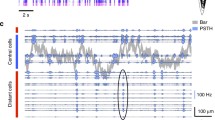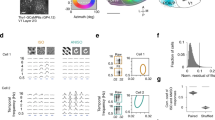Abstract
Information maximization has long been suggested as the underlying coding strategy of the primary visual cortex (V1). Grouping image sequences into blocks has been shown by others to improve agreement between experiments and theory. We have studied the effect of temporal convolution on the formation of spatiotemporal filters—that is, the analogues of receptive fields—since this temporal feature is characteristic to the response function of lagged and nonlagged cells of the lateral geniculate nucleus. Concatenated input sequences were used to learn the linear transformation that maximizes the information transfer. Learning was accomplished by means of principal component analysis and independent component analysis. Properties of the emerging spatiotemporal filters closely resemble the three major types of V1 cells: simple cells with separable receptive field, simple cells with nonseparable receptive field, and complex cells.
Similar content being viewed by others
References
Attneave F (1954) Some informational aspects of visual perception. Psychol. Rev. 61:183-193.
Barlow H (1972) Single units and sensation: A neuron doctrine for perceptual psychology? Perception 1:295-311.
Bell A, Sejnowski T (1995) An information-maximization approach to blind separation and blind deconvolution. Neural Comput. 7:1129-1159.
Bell A, Sejnowski T (1997) The “independent components” of natural scenes are edge filters. Vision Res. 37:3327-3338.
Buchsbaum G, Gottschalk A (1983) Trichromacy, opponent colours coding and optimum colour information transmission in the retina. Proc. R. Soc. Lond. B 220:89-113.
Cai D, DeAngelis G, Freeman R (1997) Spatiotemporal receptive field organization in the lateral geniculate nucleus of cats and kittens. J. Neurophysiol. 78:1045-1061.
Calvin W (1999) The MIT Encyclopedia of the Cognitive Sciences. MIT Press, Cambridge, MA. pp. 148-150.
Cover T, Thomas J (1991) Elements of Information Theory. Wiley, New York.
DeAngelis G, Ohzawa I, Freeman R (1993) Spatiotemporal organization of simple-cell receptive fields in the cat's striate cortex. J. Neurophysiol. 69:1091-1117.
DeAngelis G, Ohzawa I, Freeman R (1999) Functional microorganization of primary visual cortex: Receptive-field analysis of nearby neurons. J. Neuroscience 19:1091-1117.
Dong D, Atick J (1995) Temporal decorrelation: A theory of lagged and nonlagged responses in the lateral geniculate nucleus. Network 6:159-178.
Field D (1987) Relations between the statistics of natural images and the response properties of cortical cells. J. Optical Soc. America A4:2379-2394.
Gordon B, Presson J (1982) Orientation deprivation in cat: What produces the abnormal cells? Exp. Brain. Res. 46(1):144-146.
Gordon B, Presson J, Packwood J, Scheer R (1979) Alteration of cortical orientation selectivity: Importance of asymmetric input. Science 204:1109-1111.
Graham R, Knuth D, Patashnik O (1989) Concrete Mathematics: A Foundation for Computer Science. Addison-Wesley, Reading, MA.
Hammond P (1991) On the response of simple and complex cells to random dot patterns: A reply to Skotton, Grosof and de Valois. Vision Res. 31:47-50.
Hateren J, Ruderman D (1998) Independent component analysis of natural image sequences yields spatio-temporal filters similar to simple cells in primary visual cortex. Proc. R. Soc. Lond. B 265:2315-2320.
Haykin S (1994) Neural Networks: A Comprehensive Foundation. Macmillan, New York. pp. 363-370.
Henry G, Mustari M, Bullier J (1983) Different geniculate inputs to B and C cells of cat striate cortex. Exp. Brain Res. 52:179-189.
Hotteling H (1933) Analysis of a complex of statistical variables into principal components. J. Educational Psychol. 24:417-441, 498-520.
Hubel D, Wiesel T (1959) Receptive fields of single neurones in the cat's striate cortex. J. Physiol. 148:574-591.
Hyvärinen A (1999a) Sparse code shrinkage: Denoising of nongaussian data by maximum likelihood estimation. Neural Comput. 11:1739-1768.
Hyvärinen A (1999b) Survey on independent component analysis. Neural Computing Surveys 2:94-128.
Hyvärinen A, Hoyer P, Oja E (1999) Sparse code shrinkage: Denoising by nonlinear maximum likelihood estimation. In: Advances in Neural Information Processing Systems 11 (NIPS*98). MIT Press, Cambridge, MA. pp. 1739-1768.
Hyvärinen A, Oja E (1997) A fast fixed-point algorithm for independent component analysis. Neural Comput. 9:1483-1492.
Lisman J (1999) Relating hippocampal circuitry to function: Recall of memory sequences by reciprocal dentate-CA3 interactions. Neuron 22:233-242.
Lisman J, Idiart M (1995) A mechanism for storing 7 ± 2 short-term memories in oscillatory subcycles. Science 267:1512-1514.
Lórincz A, Szatmáry B, Kabán A (2000) Independent component analysis of temporally convolved natural image sequences yields spatio-temporal filters similar to cells in primary visual cortex. In: J Bower, ed. Trends in Research: Computational Neuroscience, 2000. Plenum Press, New York.
Mignard M, Malpeli J (1991) Paths of information flow through visual cortex. Science 251:1249-1251.
Olshausen B (1996) Learning linear, sparse, factorial codes. Technical Report AI Memo 1580, CBCL 138, Artificial Intelligence Lab, MIT, Cambridge, MA.
Olshausen B, Field D (1996) Emergence of simple-cell receptive field properties by learning a sparse code for natural images. Nature 381:607-609.
Olshausen B, Field D (1997) Sparse coding with an overcomplete basis set: A strategy employed by V1? Vision Res. 37:3311-3325.
Parker A, Hawken M (1987) Hyperacuity and the visual cortex. Nature 326:105-106.
Pearson K (1901) On lines and planes of closest fit to systems of points in space. Philosophical Magazine 2:559-572.
Saul A, Humphrey A (1990) Spatial and temporal response properties of lagged and nonlagged cells in cat lateral geniculate nucleus. J. Neurophysiol. 64:206-224.
Sillito A (1979) Inhibitory mechanisms influencing complex cell orientation selectivity and their modification at high resting discharge levels. J. Physiol. (Lond.) 289:33-53.
Tailor D, Finkel L, Buchsbaum G (2000) Color opponent receptive fields derived from independent component analysis of natural images. Vision Res. 40:2671-2676.
van Hateren J, van der Schaaf A (1998) Independent component filters of natural images compared with simple cells in primary visual cortex. Proc. R. Soc. Lond. B 265:1-8.
Westheimer G (1981) Visual hyperacuity. Prog. Sensory Physiol. 1:1-37.
Wimbauer S, Wenish O, Miller K, van Hemmen J (1997) Development of spatiotemporal receptive fields of simple cells: I. Model formulation. Biological Cybernetics 77:456-461.
Zigmund M, Bloom F, Landis S, Roberts J, Squire L (1999) Fundamentals of Neuroscinece. San Diego, Academic Press.
Author information
Authors and Affiliations
Rights and permissions
About this article
Cite this article
Szatmáry, B., Lőrincz, A. Independent Component Analysis of Temporal Sequences Subject to Constraints by Lateral Geniculate Nucleus Inputs Yields All the Three Major Cell Types of the Primary Visual Cortex. J Comput Neurosci 11, 241–248 (2001). https://doi.org/10.1023/A:1013723131070
Issue Date:
DOI: https://doi.org/10.1023/A:1013723131070




